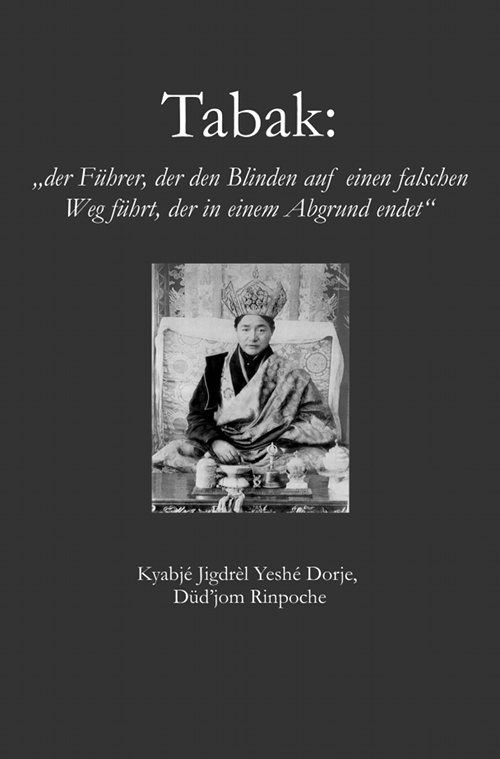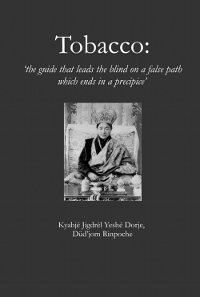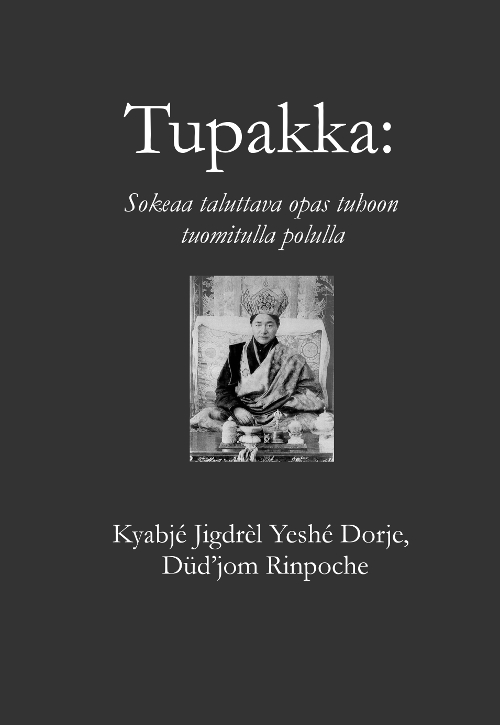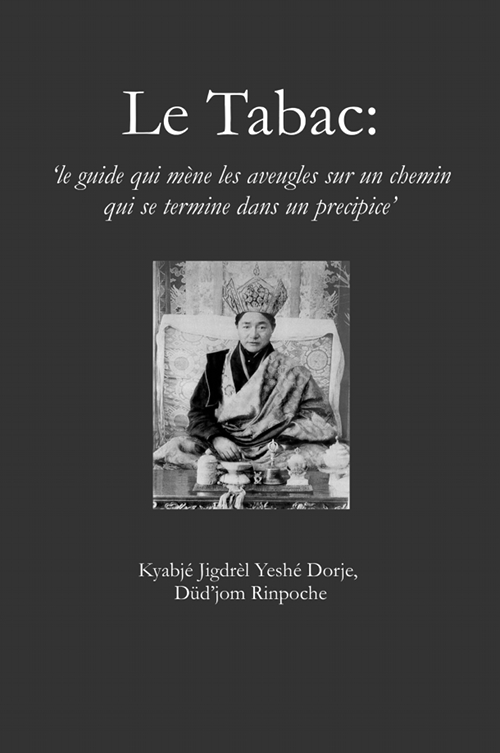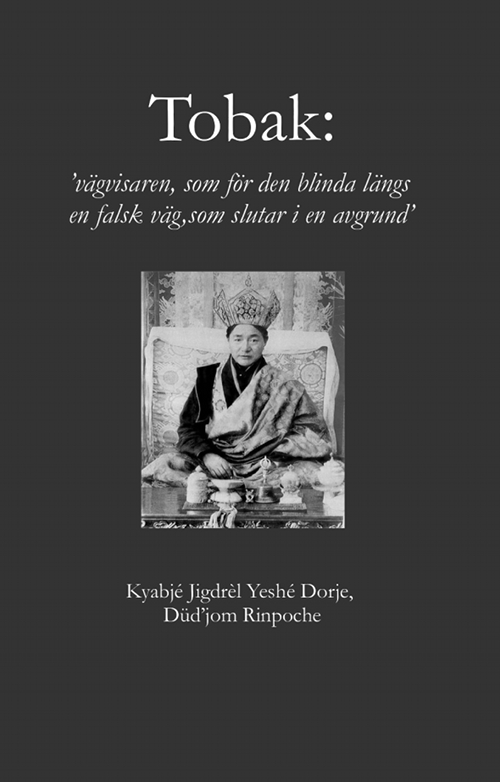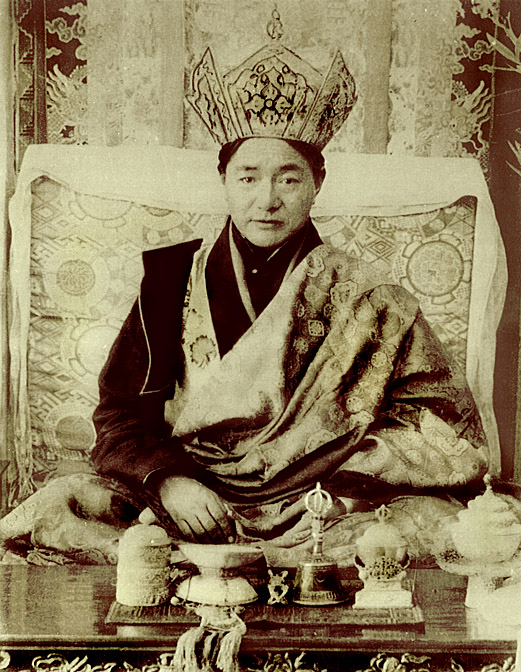
Kyabjé Düd’jom Rinpoche
Biography
Kyabjé Düd’jom Rinpoche – Jig’drèl Yeshé Dorje – is acknowledged as having been the greatest Vajrayana Master of the 20th century by all Lamas who are revered today. His ‘History and Fundamentals of the Nyingma’ has become the English language text above all others that depicts the Nyingma Tradition for students in the West, and the debt of gratitude we owe to this sublime Master is beyond measure.
Ngak’chang Rinpoche says of Kyabjé Düd’jom Rinpoche:
Kyabjé Düd’jom Rinpoche was undoubtedly the Imperial Yogi and
Scholar of the previous century – yet possessed of a natural
‘ordinariness’ that placed him in a category of his own . He was expert
in all fields – a poet, historian, musician, and composer of Dohas – a
Mahasiddha beyond compare. The appellation Dzogchen has come to be employed as an
honorific in respect of several Lamas in terms of those who are deemed the epitome of
the 9th Vehicle – but of Kyabjé Düd’jom Rinpoche there is no
need for such a description, as it is implicit in the name Düd’jom
Rinpoche. Every Nyingma Lama alive today is his disciple – as are many
Kagyüd Lamas – particularly of the Drukpa and Drigung lineages.
Kyabjé Chag’düd Tulku Rinpoche, Lama Tharchin Rinpoche, Lopön
Ögyen Ten’dzin Rinpoche and many other Nyingma Lamas revered in the West
have continued devotion to Kyabjé Düd’jom Rinpoche, undiminished by
time. All my Lamas looked to him as their inspiration and guide, and—when they
spoke of him—their devotion and simple humility were searing. Kyabjé
Düd’jom Rinpoche exemplified everything that is brilliantly perfect,
consummately glorious, humanly compassionate, and vividly unsullied within Vajrayana,
and those who had the inestimable privilege to receive transmission and teaching from
him remember him always as the living presence of Padmasambhava. Kyabjé
Düd’jom Rinpoche was the sublime Nyingma Master and my grief at his
passing cannot be expressed or allayed – other than in the joy of having met
his son and heir Dung-sé Thrin-lé Norbu Rinpoche.
Kyabjé Düd’jom Rinpoche – Jig’drèl Yeshé Dorje (sKyabs rJe bDud ’joms jigs bral ye shes rDo rJe), the incarnation of Ga’wang Düd’jom Lingpa – stood at the perfect juncture between æons. In the previous world epoch he was the Buddha Nuden Dorje, and in the next epoch he will appear again as the Buddha Möpa ’öd-Thayé. When in the future the Vajrayana is imperilled, he will reincarnate as Dorje Nönpo, the King of Shambhala, who will restore the Vajrayana. In the 20th century he manifested as the Buddha Padmasambhava in person.
Ga’wang Düd’jom Lingpa (mnGa’ dBang Dud ’joms gLing pa, 1835-1904), was an astounding teacher, meditation master, and gTértön. He was renowned for profound visionary insights, which commenced when he was but three years of age. Ga’wang Düd’jom Lingpa revealed the cycle of Tröma Nakmo, the Wrathful Black Mother, which is practised widely among Nyingma Lamas and their disciples both in the East and West. It was the central practice of Lama Yeshé Dorje Rinpoche, the famous Mahayogi and weather master. Ngak’chang Rinpoche received this cycle from Kyabjé Düd’jom Rinpoche and practised it intensively under the guidance of Lama Yeshé Dorje Rinpoche for five years. Thirteen of Ga’wang Düd’jom Lingpa’s disciples attained rainbow body through the Tröma Nakmo cycle of practices.
In the predictions of gTértön Ögyen Déchen Lingpa it is
recorded:
In the future—in the eastern hills of the Nine Peaked
Mountain—in the realised dimension of the self-originated Dorje Phagmo, an
incarnation of Drogben Khyéchung Lotsa will be born of noble lineage, and he
will be named Yeshé. His wonderful activities will all accord with Vajrayana.
He will manifest unexpectedly as a little boy with astonishing intelligence. He will
discover new gTérma and preserve the old gTérma, and whomsoever has
connection with him will travel with him on their death to the dimension of
Zangdokpalri.
Kyabjé Düd’jom Rinpoche’s previous incarnations included Shariputra (the disciple of Buddha Shakyamuni), the Mahasiddha Saraha, the Mahasiddha GagaSiddhi, the Mahasiddha Hungkara, Trig-na’dzin (religious minister of King Indrabhuti), Drogben Khyéchung Lotsa (one of the twenty-five disciples of Padmasambhava and Yeshé Tsogyel), Düd’dül Rolpa-tsal, Sonam Détsen (both the physical and spiritual son of gTértön Long-sèl Nyingpo), Traktung Düd’dül Dorje, Hépa Chöjung, Ngakpa Drum-gyi Kar, Chögyal Phagpa, Dampa Désheg (Dam pa bDe gShegs, 1122-1192, who founded Ka thog dGon in 1159), and Lingjé Répa (gLing rJe Ras pa,1128-88 – Tsawa’i Lama of the first Gyalwang Drukpa Tsangpa Gyaré Yeshé Dorje).
In terms of the prediction of gTértön Ögyen Déchen Lingpa, Düd’jom Rinpoche was indeed of noble descent. His family lineage goes back to Nyatri Zangpo and Powo Khanam Dépa, the Chögyal of Powo. His father was Ngakpa Kathog Tulku Norbu Ten’dzin, the illustrious direct descendant of Trisong Détsen, born in the Hidden land of Pemakö. His mother—Namgyal Drölma—was a Dakini descended directly from gTértön Ratna Lingpa. He was thus thoroughly immersed in the gö kar chang lo tradition from many generations of his family in both the bone-lineage of his father and blood-lineage of his mother. He was born in Pemakö in 1904 (early in the morning of the tenth day of the sixth month of the Water Dragon year) accompanied by many miraculous occurrences and portents.
His previous incarnation—gTértön Düd’jom
Lingpa—advised his disciples:
In this degenerate time, it would be wise
to go to the secret land of Pemakö. Whoever relies on me should go in that
direction to find me again. Before you youngsters get there, I—the old
one—will be there already.
When Düd’jom Lingpa decided it was time to leave his body and take another incarnation he started making a carriage for himself. Seeing this, some of his elderly disciples immediately started their journey for Pemakö (knowing that the journey could take them a year). The size of the carriage caused some confusion for those who did not understand – as it was made for a child. Understanding dawned, however, when they found Düd’jom Lingpa in an unmoving meditation which continued for several weeks. Ga’wang Düd’jom Lingpa had left his body. Exactly as predicted, the incarnation of gTértön Düd’jom Lingpa was discovered in Pemakö. He was three years old when they recognised him. Kyabjé Düd’jom Rinpoche was a direct incarnation of Düd’jom Lingpa and therefore remembered not only his past life clearly – but all his previous lives.
First, Phuktrül Gyür’mèd Ngédön Wangpo and Thubten Chönjor Rinpoche of Ling came to Pemakö to enthrone Kyabjé Düd’jom Rinpoche, and then many other disciples of the previous gTértön Düd’jom Lingpa arrived. As Kyabjé Düd’jom Rinpoche was taught, he was able to comprehend through mere indication and he absorbed many texts and commentaries in this way. According to Könrab Rinpoche, Kyabjé Düd’jom Rinpoche began to discover gTérma when he was five years old.
He studied for sixteen years with Phuktrül Gyür’mèd Ngédön Wangpo (the holder of the teachings of the Düd’jom Lingpa) and from Jamyang Khyentsé Wangpo Rinpoche he received the Gyüd, Lung, and Men-ngag of the Sangwa Nying-thig. He received many gTérma teachings from both Gédrung Thrin-lé Jampa Jung-né Rinpoche and Gyür’mèd Ngédön Wangpo Rinpoche, and understood everything immediately. By merely listening to the Shé-rig Dorje Nönpo Gyüd his intelligence display opened and all the Vajrayana Tantras unfolded naturally.
After this, Ngédön Wangpo confided to Kyabjé
Düd’jom Rinpoche:
The gTér-dzöd is the wisdom-activity
of both Jamyang Khyentsé Wangpo Rinpoche and Jamgön Kongtrül
Rinpoche of Séchen. I have given transmission of the gTér-dzöd
five times, but you will give it ten times.
At the age of thirteen, Kyabjé Düd’jom Rinpoche experienced the presence of Padmasambhava and Yeshé Tsogyel in person, and the Yeshé Khandros presented him with the yellow documents from which he transferred gTérmas to script.
Kyabjé Düd’jom Rinpoche received both the Wang and rLung of the Dzogchen Nying-thig Yabshi (the lineage of Nyoshul Lungtok Tenpa’i Nyima) from Togden Tenpa Rinpoche. He consequently travelled to ü-Tsang and received the Kangyür lung, Dam-ngag Dzöd, Sangchen Ngépa’i Nying-thig Yabshi and all the Dzogchen teachings from Jédrung Rinpoche, Düd’jom Namkha’i Dorje Rinpoche and Tulku Künzang Thegchog Tenpa’i Gyaltsen.
Kyabjé Düd’jom Rinpoche received the gTérmas of Pema Lingpa and the Dzöd Dun from Ngaktsün Gendün Gyamtso – and from Minling Dorje Lopön Rinpoche and Namdröl Gyatso Rinpoche he received the gTérmas of gTérdag Lingpa.
From Khenpo Jamdé ’ö-Zér (a disciple of Mipham Rinpoche), he received Mipham’s great commentaries, the Nyingma Kagyèd, Sangye Lingpa’s Lama Gongdü, the Sangwa Nyingpo (according to the Zür tradition), the ’ö-Sèl Sangwa Nying-thig, and the Nying-thig Yabshi.
Kyabjé Düd’jom Rinpoche received teachings from disciples of the great Nyoshul Rinpoche, Lamas such as: Ngawang Palzang Rinpoche, Chatral Sang-gyé Dorje Rinpoche, Ögyen Rig’dzin Rinpoche, Kathog Chagtsa Rinpoche, and Pulung Sang-gyé Rinpoche.
Kyabjé Düd’jom Rinpoche then went to a secret vicinity called Phüntsog Gatsèl, and accomplished the essence of Dorje Phurba and the Düd’jom Namchag Pu-tri. At Tséphug he performed Tsédrüp rites and his Long-life chang boiled. He received the portents when he practised the Gong gTér of Düd’dül Tröllö (the Düd’jom Dorje Tröllö gong gTér). In Paro Taksang, he rediscovered the Putri Répung, the Tsokyé Thugthig and the Khandro Thugthig.
Whilst Kyabjé Düd’jom Rinpoche worked to preserve the old gTérmas, he had no time for the rediscovery of new gTérmas – even though he knew they existed both at Samyé and at Taktsang. As prophesied, he gave the Rinchen gTér dzöd ten times, and gTértön Pema Lingpa’s Palden Chö’khor three times. He gave transmission of Ga’wang Düd’jom Lingpa’s gTérmas many times – as well as the Ja’tsün Po-trug and the Nyingma Gyüdbum.
Kyabjé Düd’jom Rinpoche wrote twenty-three volumes of Gong gTér – all of which have been printed. He also collected all the Kama (Long Transmission teachings of the Nyingma lineage), just as Jamgön Kongtrül of Séchen had collected all the gTérmas. He printed the Nyingma Gyüd’bum (rNying ma rGyud ’bum – the Hundred Thousand Tantras of the Ancient Tradition), a collection of texts belonging to the Three Inner Tantras, gathered by gTértön Ratna Lingpa (gTer sTon Chos rGyal Rat na gLing pa,1403-1478) and collated by gTértön Jig’mèd Lingpa (gTer sTon ’jigs ’med gLing pa, 1729-1798). In Pemakö, he established many new centres for both monastics and the gö kar chang-lo’i dé (gos dKar lCang lo’i sDe).
Lopön Ögyen Ten’dzin Rinpoche says:
Of all the Lamas of
the Nyingma Tradition, Kyabjé Düd’jom Rinpoche was the one who was
the most kind to the gö kar chang-lo’i dé. He helped the ngakpas a
great deal, especially in exile, having special shawls woven for them in Bhutan.
Since his passing no one has really cared for the gö kar chang-lo’i
dé as he did, and the White Sangha are again in danger of disappearing from
the world. Kyabjé Düd’jom Rinpoche asked four Lamas if they would do
something for the benefit of the gö kar chang-lo’i dé after his
death, but at the time I had been trying alone. This is why I am so happy that
Ngak’chang Rinpoche and Khandro Déchen are making the gö kar chang-lo’i dé known and
that they are making it possible to have a school for ngakpas and ngakmas in
Pemakö.
Kyabjé Düd’jom Rinpoche organised many texts which had been disparate and dispersed and it is solely due to his kindness that these texts and empowerment manuals remain extant. In Kongpo he rebuilt the Tha’dül Buchu Lhakhang and Zangdokpalri Gompa. He constructed the Vajrayana Centres Lama Ling in Tso Pema, Tsé-chü Gompa in Darjeeling, Düd’dül Rabten Ling in Orissa, and Zangdokpalri Gompa in Kalimpong. In America he established many Dharma centres and retreat centres under the name of Yeshé Nyingpo. In France he established Dorje Nyingpo in Paris, and Ögyen Samyé Chöling Centre in the Dordogne. In Britain he established Ögyen Chöling in London, and although this centre is no longer there, many disciples of Kyabjé Düd’jom Rinpoche continue in the Düd’jom gTér tradition in Britain with Lopön Ögyen Ten’dzin Rinpoche. In Wales he established Sang-ngak-chö-dzong for the preservation and propagation of the gö kar chang-lo’i dé (gos dKar lCang lo’i sDe) under the spiritual guidance of Ngak’chang Rinpoche and Khandro Déchen.
Ngak’chang Rinpoche attended every teaching and empowerment given by Kyabjé Düd’jom Rinpoche in Britain, and it was Kyabjé Düd’jom Rinpoche who encouraged Ngak’chang Rinpoche to dedicate himself to the establishment of the gö kar chang-lo’i dé in the West.
Ngak’chang Rinpoche comments:
Kyabjé Düd’jom
Rinpoche was extremely kind to me on so many occasions in London and in Bodha,
Kathmandu. Even in his encouragement to me for the work of preserving and propagating
the gö kar chang-lo’i dé he seemed to wish me only to proceed if it
was also my heartfelt wish. He told me that there would be many difficulties and
obstacles and that I would be subject to mikha [malicious gossip and negative
speech]. He said that few would help me in this and that I would have to continue
without assistance for a long time before I would find support. I replied to the
effect that the only thing in life that would seriously deject me would be the loss
of his good opinion. Kyabjé Düd’jom Rinpoche then gave the name
‘Sang-ngak-chö-dzong’ (gSang sNgags chos rDzong – Fortress of
Secret Mantrayana) in respect of the work of supporting the gö kar chang lo in
the East and establishing it in the West. Kyabjé Düd’jom Rinpoche
gave me one of the Ngak’phang shawls he had had made specially in Bhutan for
the Nyingma gö kar chang lo Lamas, and this is one of my greatest treasures. I
hope that this shawl will survive for many centuries as a reminder of the great
kindness of Kyabjé Düd’jom Rinpoche to the gö kar
chang-lo’i dé.
Since promising Kyabjé Düd’jom Rinpoche that I would
dedicate my life to the preservation and propagation of the gö kar
chang-lo’i dé, I have done whatever I could to make the White Sangha
wing of the Nyingma known in the world. What Kyabjé Düd’jom
Rinpoche said proved to be true with regard to obstacles and difficulties – and
for almost twenty years it was a matter of having to be rather resilient. Our
disciples have been of immense support and now at last Khandro Déchen and I
have wonderful support for this work in the West. Kyabjé Künzang Dorje
Rinpoche and Jomo Sam’phel have always given us their inspiration and guidance,
of course, but now we have the esteemed pragmatic collaboration of Lopön Ögyen Ten’dzin Rinpoche.
Khandro Déchen and I can now happily say that the promise to Kyabjé
Düd’jom Rinpoche can be kept.
When we requested Dung-sé Thrin-lé Norbu Rinpoche to write a
long-life wish-path for Kyabjé Künzang Dorje Rinpoche and Jomo
Sam’phel, Rinpoche was incredibly magnanimous, and the text he wrote is a
profound teaching which covers all aspects of the Inner Tantras as well as placing
the gö kar chang-lo’i dé in context as half of the tradition
bequeathed to us by Padmasambhava. Anyone who reads this marvellous text can be left
with no doubt that the gö kar chang lo is an authentic tradition with ancient
and unquestionable roots in the establishment of Buddhism in Tibet. To have such a
connection with the sublime son of Kyabjé Düd’jom Rinpoche assures
us that the gö kar chang-lo’i dé will survive and prosper for the
benefit of everyone and everything everywhere.
Whenever Kyabjé Düd’jom Rinpoche gave teachings in Tibet and India, great Lamas such as the two Mindröl Ling Lamas, Trülshik Rinpoche, and Chatral Sang-gyé Dorje Rinpoche came to receive them. Among all the important Lamas there are none who did not receive teachings and transmissions from Kyabjé Düd’jom Rinpoche, as they all had great confidence in his realisation. His students numbered in the thousands and came from every continent.
Kyabjé Düd’jom Rinpoche manifested Nya-ngèn Lédé pa Chenpo’i (nya ngan las ’das pa chen po’i – mahaparinirvana) on the 17th of January in the year 1989 accompanied by many miraculous signs. He bequeathed his body as a sign of the dissolution of Nirmanakaya into Dharmakaya – his body shrunk to twenty percent of its former size and presently resides in the precincts of the Great Chörten in Bodha, in the Kathmandu Valley of Nepal.
Kyabjé Düd’jom Rinpoche’s incarnation Yang-srid Tulku Yeshé Dorje was born on the 9th of October 1990 and currently lives in Yang-lé-shöd, Nepal.
Here follow the incarnations in the Düd’jom lineage:
1 Nuden Dorje, disciple of the Buddha of the previous æon, Sang-gyé Rinchen Nyingpo (Sangs rGyas Rin chen sNying po).
2 Shariputra: chief disciple of Buddha Shakyamuni.
3 Saraha, the preëminent Mahasiddha, composer and singer of Dohas.
4 Krishnadhara: chief minister of Indrabhuti of Ögyen.
5 Humkara: one of the eight Rig’dzins and holder of Yangdag thugs.
6 Drogben Khyéchung Lotsa: the great translator and one of the Twenty-five Tibetan disciples of Padmasambhava and Yeshé Tsogyel.
7 Smritijnana: one of the Indian Panditas in Tibet.
8 Rong’dzom Pandita: scholar and redactor of the Nyingma Kama.
9 Dampa Désheg: founder of Kathog Gompa in Kham.
10 Ling-jé Répa: founder of the Drukpa Kagyüd school.
11 Chögyal Phagpa: nephew of Sakya Pandita, ruler of Tibet and Lama of the Kubla’i Khan.
12 Ngak’chang Drumkhar Nakpo (Lama from Kham who dwelt for eighteen years in muntsam – dark retreat).
13 Héwa Chöjung: Khamba magician and subjugator of enemies of Vajrayana.
14 Traktung Düd’dül Dorje: the gTértön who rebuilt Kathog.
15 Gyaltsé Sonam Détsen: head of Kathog.
16 Düd’dül Rolpa-tsal: gö kar chang lo Lama of Kunkhyen Jig’mèd Lingpa.
17 Ga’wang Düd’jom Lingpa (1835-1904), born in Chagkong in Kham in the gö kar chang lo family of Gili (Gili gTértön and Phurba gTértön were both known for siddhis).
18 Düd’jom Jig’drèl Yeshé Dorje (1904-1989).
